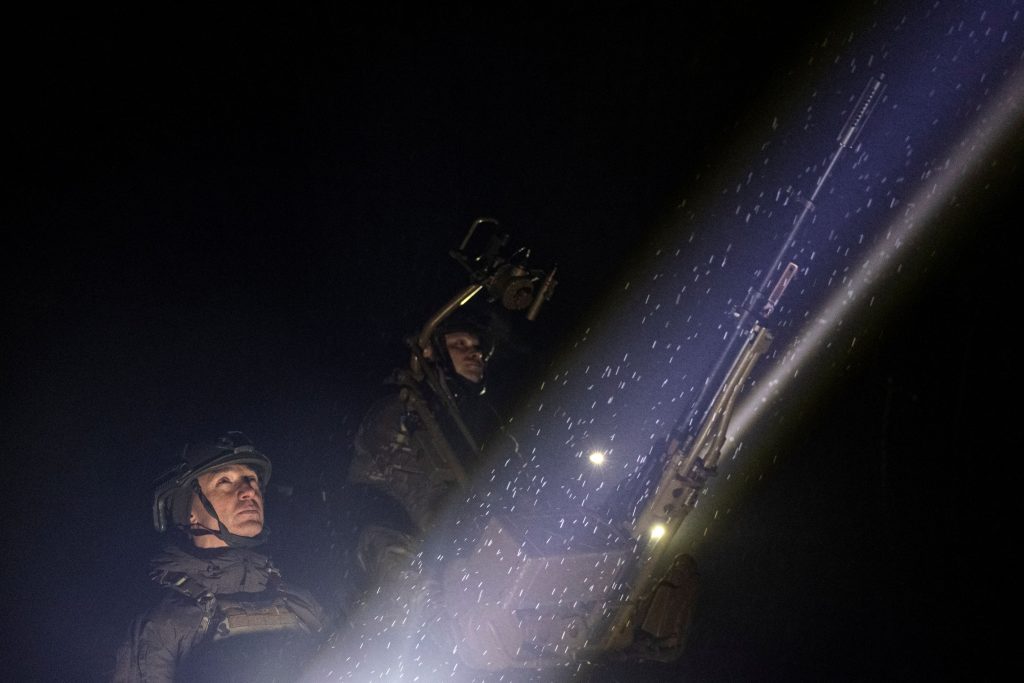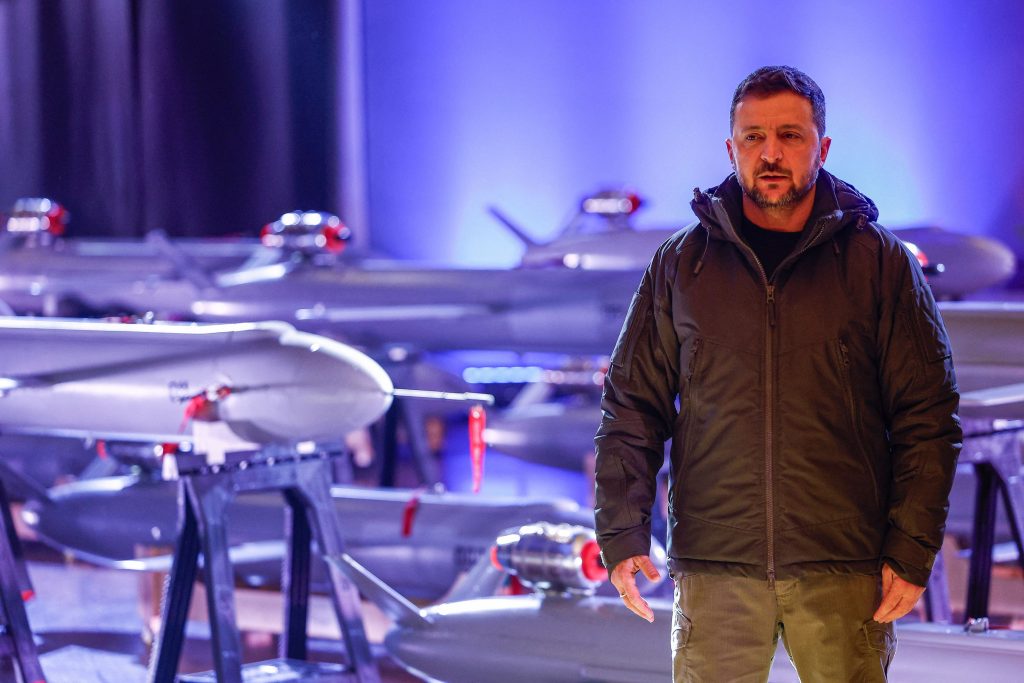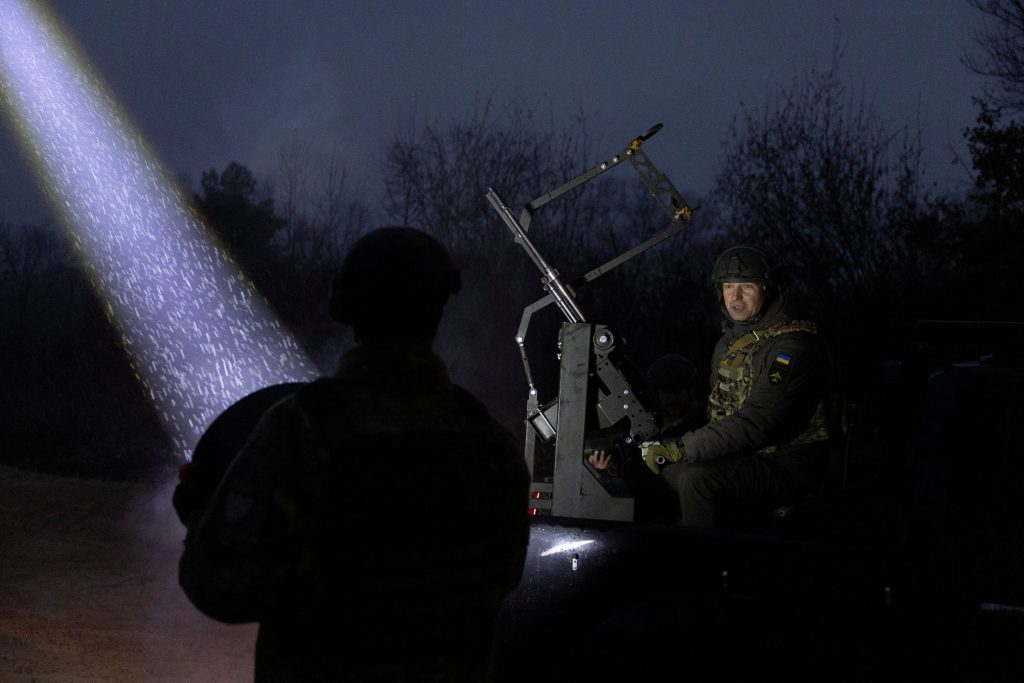POLTAVA, Ukraine—A team of soldiers sat inside a nondescript red bus with their eyes glued to a bank of screens blinking with yellow dots. The shapes represented Russian drones, missiles and planes cutting into Ukrainian skies. Soldiers from Ukraine’s 164th Radiotechnical Brigade were trying to quickly identify targets and intercept them before they could sow destruction in towns and cities.

Vladyslav Tsukurov, judge and spokesperson of Bila Tserkva district court, assists Leonid Merzlyi, Head of Irpin town court, as they observe the sky during a combat shift of their air defence volunteer unit, amid Russia’s attack on Ukraine, in Kyiv region, Ukraine November 30, 2024. REUTERS/Valentyn Ogirenko
In recent months, the number of dots on the screens has mushroomed, with Russia’s stocks bolstered by a new drone factory and North Korean ordnance.
Russia fired more than 6,000 explosive drones and missiles against Ukraine over September, October and November, according to a Wall Street Journal analysis of daily data from the Ukrainian Air Force Command. That was over three times the number it fired over the previous three months, and more than four times the number fired during the same fall months in 2023.
Russia is using an unprecedented number of Iranian-designed Shahed drones, and it is using more ballistic missiles, which are harder to intercept. One of Moscow’s new tactics is to fly fleets of cheap decoy drones to exhaust Ukraine’s air defenses. It is using thermobaric warheads and radar-evading missiles.
“The point is to exhaust the air defense capabilities,” said Maj. Anton Yanovych, a commander of the 164th. He said there are days when he sleeps less than two hours. His bus is equipped with a shower, a kitchen, bunk beds and a fridge to make operators comfortable as they keep constant watch.
Ukraine is scrambling to counter the attacks with increased use of electronic warfare jamming techniques, but the soldiers are struggling. They lack enough modern missile defenses to keep up with the Russian barrages.
The increased bombardments , which have caused civilian casualties and degraded Ukraine’s electricity grids, threaten to further undermine Ukrainian morale as Russia takes more territory in the east. But they also demonstrate Russia’s increased dependence on allies, as it copies Iranian drones and uses North Korean missiles.
Ukraine’s ability to intercept missiles has improved after deteriorating earlier this year, according to the data. In October, 93% of all drones were intercepted or lost, compared with just over 8% of ballistic and hypersonic missiles.
The data for several days was incomplete, and Ukraine uses such statistics for propaganda purposes. But the Journal’s conclusions based on the data align with reports of the attacks, first-hand accounts and comments by Ukrainian officials.
The West has delivered more air-defense systems to Ukraine that are capable of downing modern missiles, but Ukrainian President Volodymyr Zelensky says the country needs much more.
Ukraine is using electronic jamming to send Russian drones off course and down them with increasing success, while Russia’s own version of Iran’s Shahed drones has led to reduced quality, according to a Ukrainian official.

Ukraine’s President Volodymyr Zelenskiy visits an exhibition of new Ukrainian-made drone-missiles Peklo dedicated to the Day of Ukrainian Armed Forces, amid Russia’s attack on Ukraine, in Kyiv, Ukraine December 6, 2024. REUTERS/Valentyn Ogirenko
The Ukrainians have to be flexible and react immediately to changes in Russian tactics, said Valeriy Romanenko, a former Ukrainian air defense officer and a researcher at Kyiv’s National Aviation University. “Whoever comes up with solutions faster will win the battle for the skies,” he said.
Russia inundated Ukraine with long-range Shahed drones first supplied by Iran but now also made at a factory in Tatarstan region some 600 miles east of Moscow. Over the past three months, 92% of all long-range aerial munitions fired were drones and their decoys, according to the data. Because they don’t reach a target, Ukraine refers to these decoys, alongside explosive drones downed by electronic warfare, as lost.
Russia can build 1,200 of these drones a month at its Tatarstan factory, according to the Ukrainian official. But Russia’s version of the Shahed uses different electronic components than the Iranian original, the official said.
Ukraine has said that up to half the drones fired can sometimes be unarmed decoys. The decoys are made to replicate a Shahed on radars through a device that reflects radar waves in a way that confuses the receptor as to its size, according to reports in Russian media and Ukrainian officials.

A drone view shows an apartment building hit by a Russian drone strike, amid Russia’s attack on Ukraine, in Ternopil, Ukraine December 2, 2024. Press service of the State Emergency Service of Ukraine in Ternopil region/Handout via REUTERS
The decoys stretch Ukrainian defense and waste its already sparse ammunition for air defenses. They can also sometimes film and transmit data on Ukrainian positions.
Russian drones marked by spotting units such as Yanovych’s team in the bus flash up on the tablet screens of the mobile groups, like one positioned in a field near Poltava last week. The duo—Sr. Sgt. Vasiliy Kopcha and Pvt. Volodymyr Khomyak—use a Soviet-era machine gun mounted on the back of a pickup truck that can hit targets more than a mile away. Kopcha climbed into the gunner’s seat welded atop the back, while Khomyak monitored the airspace on a tablet.
Some units are staffed by volunteers coordinating with the armed forces and driving toward targets to knock them down. Others, such as Kopcha and Khomyak, are part of the armed forces, responsible for keeping watch over an area assigned to them.
“They use the landscape,” Kopcha said, pointing at a hilly field, “Either they hide and fly low, so the radar doesn’t see them, or they fly above the cloud cover and we can’t reach them.”
The gray December sky is low, and although he has a thermal scope, Kopcha says Russians use the cloud cover to mask their craft from mobile groups such as his.
“It’s like a car,” he said, “you hear it vroom and it’s gone.”
Mobile air-defense units have been forbidden from approaching any drones they shoot down because some are programmed to delay detonation long after they hit the ground in an attempt to wound the air defenders.
Some Shahed drones are programmed to avoid any locations where they previously encountered mobile groups. If one is shot down over a location, others avoid it for about a month, radiolocation groups say. Shaheds have learned to fly over forests or marshes where mobile units can’t be stationed. Some fly toward one target only to then turn around and fly to a different one. Recently, Russia began painting the attack drones black to make them more difficult to see at night.
There are times when Kopcha and Khomyak are on duty for 16 hours, waiting for drones to fly in their direction. They have invested in quality thermal wear to insulate themselves from the harsh Ukrainian winter. They bring sweets and a thermos of hot tea.
Ukraine is increasingly using electronic warfare to counter drones.

Vladyslav Tsukurov, judge and spokesperson of Bila Tserkva district court, speaks to his team mate Ilarion Rudyk, judge of Holosiivskyi district court in Kyiv city, as they observe the sky during a combat shift of their air defence volunteer unit, amid Russia’s attack on Ukraine, in Kyiv region, Ukraine November 30, 2024. REUTERS/Valentyn Ogirenko
When a drone flies into the GPS-spoofed zone, it registers as being in a different location—Belarus, for example, instead of Ukraine. It then flies off course in an attempt to correct its direction. Once it exits the zone, it goes back to attempting to hit its target, but the spoofing exhausts fuel and gives air defenses more time to work.
Ukrainian authorities say precious little about how the technology functions to avoid giving Russia information it can use to counter it. But it is another way Ukraine can deny Russia dominance in its airspace without using the limited ammo it has for Western systems.
Russia has tried to keep up. It started to fit electronic-warfare devices on its own missiles as a way to throw off Ukraine’s vintage Soviet air-defense systems, according to Yuriy Ihnat, a representative of Ukrainian Air Force Command.
“It’s a case of who can outplay whom,” said Ihnat.
Sometimes, the hunters can become the hunted. Russians send Orlan reconnaissance drones to try to locate units such as Yanovych’s team in the bus.
When they spot a Russia spy drone above them, “that’s the first signal that it’s time to go,” he said.
Write to Alistair MacDonald at Alistair.Macdonald@wsj.com



